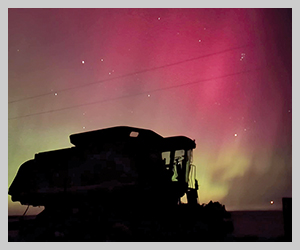
On one of the snowiest days so far this year, 34 growers made the trek to Spokane to hear Allison Thompson, market analyst and owner of The Money Farm, talk about the markets as part of the Agricultural Market and Management Organization’s 2023 winter schedule.
Thompson highlighted the market’s volatility, telling growers, “There are definitely many moving headlines, not only here in the U.S., but also globally, so make sure you are keeping those in mind when you are doing your grain marketing this next year.”
There are four main factors playing a role in the market’s volatility:
- The economy. Although inflation has come down recently, it is still relatively high. Thompson pointed out that there have been eight interest rate increases since March 2022 with talk of several more through June of this year. The high U.S. dollar is also lowering demand for U.S. grain.
- Energy markets. According to Thompson, the forecast through the first half of 2023 is oil supply will meet demand, but if China’s economy comes back, it could cause a deficit. In addition, the Biden Administration has said it will release more oil from the U.S. strategic reserves, which will take the reserves to a 40-year low. Russia has said it will lower crude oil production to help oil prices within the country, but OPEC hasn’t given any indication about making production changes going forward.
- Geopolitical headlines. Thompson said the wheat market has been susceptible to any headlines on the Russia/Ukraine war, especially in regards to the export agreement, which was set to expire March 18. “Even with the Russia/Ukraine deal likely going forward, it’s just such a major part of what’s influenced our markets for so long this year that when we start seeing those headlines dissipate, markets are likely just going to fall on that news alone, regardless of what the fundamentals do,” she explained. The other big geopolitical headline is supply and demand issues from China, which is just starting to open up from COVID-19 and dealing with its own potential inflation issues. During COVID-19, the country went through much of its grain reserves, which will need to be restocked. Thompson said they’ll either come to the U.S. or to South America to purchase grain.
- Weather. The world’s focus has shifted to the Southern Hemisphere as they wrap up their harvest. Argentina has been very dry, hitting an eight-year low on production this year. Their main export partner is Brazil, so much of their crop tends to stay in South America. Australia, the world’s third largest wheat exporter, had another year of record production, but extremely wet weather means a large part of their crop will likely become feed wheat. One of Australia’s biggest issues is shipping capacity at their ports and terminals; there’s some talk that they could run out of capacity as the crop comes in.
The overall outlook is that there is record high global wheat production, but that’s coupled with demand that has been trending higher since 2020, something Thompson didn’t think was going to change. In addition, the U.S. is looking at a 15-year low for wheat ending stocks, which is keeping U.S. prices high. Argentina and Canada are in the same boat due to their production issues.
“There’s a lot of talk out there that high prices cure demand. I don’t believe that. We’ve never seen demand go down, and I don’t think it’s going to,” she said. “My fear is the market is maybe getting used to that (high prices). Everywhere in the world can grow wheat, so it isn’t so reliant on us, and I think the world is starting to realize that as well. For quality wheat, I think the U.S. is on top of that on the global marketplace, but as of right now, the world just wants cheap wheat, and we are not it.”
Looking forward, Thompson’s recommendations include keeping an eye on corn. If the market is able to hold support on corn futures, she thinks wheat has a chance to hold onto support as well. She said the Chicago market is the “ugliest” of all wheat markets, as it had been hitting new lows recently at the end of February, and “wherever Chicago goes, Minneapolis and Kansas City wheat are likely to follow.” She was hopeful, though, that the market was near the bottom and would start heading up.
“When we get a good 20 cent rally — and it will come — that’s when you reward the market, and that’s when you make that sale,” she advised.
Looking specifically at soft white wheat, she said basis has gotten a little better, but futures had fallen. She told growers to have orders on both sides of the market to try to reduce risk. She also advised growers to lock in input costs, if they could, and start looking at 2024 input needs.
“We’ve had a lot of change in the markets in the last couple of days. When we are getting down days, it’s even more important to be talking about the market. It’s obviously very volatile,” she said.
See Rob Froom’s take on the current market. Froom is a senior central hedge desk manager at United Grain Corporation.












